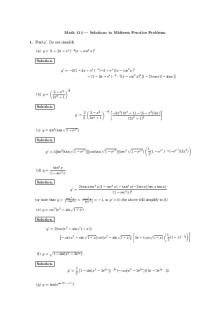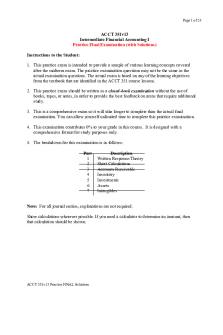Practice exam Solutions ABC(1)(1) PDF

| Title | Practice exam Solutions ABC(1)(1) |
|---|---|
| Course | Accounting for Business Combinations |
| Institution | University of Technology Sydney |
| Pages | 8 |
| File Size | 261.5 KB |
| File Type | |
| Total Downloads | 935 |
| Total Views | 1,023 |
Summary
PRACTICE Main ExamSTUDENT NUMBER:SURNAME: (FAMILY NAME)OTHER NAMES:This paper and all materials issued must be returned at the end of the examination. They are not to be removed from the exam centre.Examination Conditions: 22320 ACCOUNTING FOR BUSINESSCOMBINATIONSTime Allowed: 2 hours and 10 mins In...
Description
PRACTICE Main Exam
STUDENT NUMBER: SURNAME: (FAMILY NAME)
OTHER NAMES:
This paper and all materials issued must be returned at the end of the examination. They are not to be removed from the exam centre. Examination Conditions:
22320 ACCOUNTING FOR BUSINESS COMBINATIONS Time Allowed: 2 hours and 10 mins Includes 10 minutes of reading time. Reading time is for reading only. You are not permitted to write, calculate or mark your paper in any way during reading time.
This is a Closed Book exam Permitted materials for this exam:
Calculators (non-programmable only)
Materials provided for this exam:
This examination paper
Do not open your exam paper until instructed. Faculty of Business/ Accounting DG
Page 1 of 8
22320 ACCOUNTING FOR BUSINESS COMBINATIONS (practice main exam)
PART A: MULTIPLE CHOICE QUESTIONS
(5 marks)
5 MCQs (1 mark each). See last lecture MCQs for practice.
END OF PART A
Page 2 of 8
22320 ACCOUNTING FOR BUSINESS COMBINATIONS
PART B: NON-CONTROLLING INTEREST AND CONSOLIDATION
(15 marks)
Complete the answers to the four sections of Part B on the following pages. Required: i) Prepare a memorandum for the NCI share of profits for the year ended 30 June 2017 Account name Subsidiary $ NCI $ 30% Profit after tax 329,000 98,700 + Intra group sale of inventory realised/sold in 2017 35,000 10,500 - Tax effect (10,500) (3,150) = Adjusted profit 353,500 106,050
ii) Prepare a memorandum for the NCI share of shareholders’ equity as at 30 June 2017. Account name Subsidiary $ NCI $ Opening retained profits 705,000 211,500 - Sale of revalued inventory (21,000) (6,300) - Intra group transaction (unrealised profits) (35,000) (10,500) + Tax effect 10,500 3,150 = Adjusted opening retained earnings 659,500 197,850 + Adjusted profit 353,500 106,050 - Dividend paid (70,000) (21,000) = Closing retained earnings 943,000 282,900 Share capital 2,400,000 720,000 General reserve 580,000 174,000 FVA 21,000 6,300 Adjusted shareholders’ equity 3,944,000 1,183,200 END OF PART B
Page 3 of 8
22320 ACCOUNTING FOR BUSINESS COMBINATIONS (practice main exam)
PART C: ACCOUNTING FOR ASSOCIATES
(20 marks)
Complete the answers to the two sections of Part C on the following pages. Required: i) Prepare the equity accounting journal entries for Reggae Ltd to apply the equity method to account for its investment in Shark Ltd for the year ended 30 June 2017. DEBIT
30 June 2017 To record bargain purchase (prior) Investment in Associate Retained earnings Workings: Acquisition analysis 1 July 2015 COST Less: FVINA Issued capital Retained earnings General reserve FVA (150,000 * 70%) Bargain purchase @ 1 July 2015
216,250 216,250
285,000 1,500,000 300,000 100,000 105,000 2,005,000
501,250 -216,250
Increase in retained earnings (prior) Investment in Associate Retained earnings (400,000 - 300,000) x 25%
25,000
Share or profit Investment in Associate Share of profit in Associate (200,000 x 25%)
50,000
Dividend paid Dividend revenue Investment in Associate (100,000 x 25%)
25,000
Depreciation on revalued equipment (prior and current) Retained earnings [(215,000 - 65,000) / 8 years] x 70% x 25% Share of profit in associate [(215,000 - 65,000 )/ 8 years] x 70% x 25% Investment in associate You can round to the closest whole number. Transfer to general reserve (current) Dr Transfer to GR Cr General reserve (20,000 x 25%) Unrealised profit in inventory (prior) Page 4 of 8
CREDIT
25,000
50,000
25,000
3,281 3,281 6,562
5,000 5,000
22320 ACCOUNTING FOR BUSINESS COMBINATIONS
Retained earnings (277,000 - 202,000) x 60% [unsold=unrealised] x 70% x 25% Investment in associate
7,875 7,875
Realised profit (current) Investment in associate Share of profit in associate
7,875
Unrealised profit on sale of equipment (current) Share of profit in associate Investment in associate (780,000 - 750,000) x 70% x 25%
5,250
7,875
5,250
Realised profit on sale of equipment through consumption by the group, i.e., depreciation over 4 years. Depreciation expense in the current year is 6 months Investment in associate 656 Share of profit (5,250 / 4 years) x ½ 656 Tax effect Carrying amount at 1 July 2015 + Bargain purchase + Change in RE (from DOA to 30 June 2012) - Depreciation on revalued equipment - Unrealised profit on inter-entity sale of inventory = Carrying amount at 30 June 2016 + Profit after tax - Dividend - Depreciation on revalued equipment - Unrealised profit in cl. Inventory - Unrealised profit on sale of equip + Realised profit on sale of equip = Carrying amount at 30 June 2017
285,000 216,250 25,000 -3,281 -7,875 515,094 50,000 -25,000 -3,281 7,875 -5,250 656 540,094
prior prior prior prior current current current current current current
Income tax expense (540,094 - 515,094) x 30% Retained earnings (515,094 - 285,000) x 30% DTL (540,094 - 515,094) x 30%
7,500 69,028 76,528
END OF PART C
Page 5 of 8
22320 ACCOUNTING FOR BUSINESS COMBINATIONS (practice main exam)
PART D: ACCOUNTING FOR JOINT ARRANGEMENTS
(15 marks)
Complete the answers to the two sections of Part D on the following pages. Required (i) Beast Ltd elects NOT to adopt the fair value basis for its remaining interest in the plant and land contributed to the joint operation. Prepare all journal entries required to record the initial investment by Beast Ltd.
DEBIT Impairment of land Impairment loss -land Accumulated impairment
1,000,000 1,000,000
Initial contribution Investment in JO
17,500,00
Accumulated depreciation on plant
0 18,000,00 0 1,000,000
Accumulated impairment - land Land Plant
4,000,000 30,000,00 0 2,500,000
Gain on sale of plant (17m - 12m) x 50% Beast Ltd Plant Land
Page 6 of 8
Retained 50% @ C.Amt 6,000,000 1,500,000 (land after impairment)
CREDIT
Sold 50% @ FV 8,500,000 1,500,000
Investment in JO 14,500,000 3,000,000 17,500,000
22320 ACCOUNTING FOR BUSINESS COMBINATIONS
(ii) Prepare all journal entries recorded by Beast Ltd on 30 June 2017 to comply with AASB 11 “Joint arrangements”, including the sale of the hair conditioner. 30 June 2017 DEBIT CREDIT Share of assets Cash 1,200,000 Inventory - WIP 500,000 Plant [retained @ C.Amt = 50% x 12m] + 7,500,000 [new @ FV = 3m x 50%] Land [retained @ C.Amt = 50% x 3m] + 8,000,000 [new @ FV = 13m x 50%] Investment in JO 17,200,000 You can combine share of assets and liabilities in one entry. I am doing it separately here Share of liabilities Investment in JO Creditors
300,000
Share of COP Cost of production Investment in JO
600,000
300,000
600,000
Share of depreciation expense on plant Cost of production 7.5m x 20% Accumulated depreciation
1,500,000
Sale of output Cash Sales revenue
1,500,000
1,500,000
1,500,000
COGS 60% Inventory 40% Cost of production (600,000 + 1,500,000)
1,260,000 840,000 2,100,000
END OF PART D
Page 7 of 8
22320 ACCOUNTING FOR BUSINESS COMBINATIONS (practice main exam)
PART E: DISCUSSION QUESTION
(10 marks)
(i) Outline the arguments for the use of the management approach to segment reporting as employed by AASB 8. Advocates of the management approach argue that the information, which is reported internally, is likely to be of relevance to external stakeholders in making economic decisions. Using the management approach to segment reporting, the way in which internal segments are identified and the way in which accounting variables are measured for internal reporting purpose are also used to prepare segment reporting disclosures. Senior management and the board presumably uses internal information to evaluate past performance and to allocate resources within the firm. Their knowledge of the business should be reflected in the way that they “tailor” the internal measurement systems for this purpose. Whilst allowing firms to use non-standard measures of performance hampers comparability, it could be argued that this is offset by the increased relevance of segment reporting data presented using the management approach. (ii) List three items that form part of the reconciliations required by AASB 8. -
Amounts not allocated to segments (e.g., assets of corporate headquarters) Amounts from intra-segment transactions Differences arising from dissimilar internal and external accounting policies
(iii) What is the rationale behind the disclosure of executive pay in the annual report?
Directors have a high level of accountability to shareholders for transactions with an entity and benefits gained from the entity.
END OF PART E END OF EXAM
Page 8 of 8...
Similar Free PDFs

Practice Exam 1 Solutions
- 11 Pages

Practice exam Solutions ABC-2
- 10 Pages

Practice Solutions
- 71 Pages

CHIA Practice Practice Exam
- 22 Pages

Midterm Practice 1 Solutions
- 9 Pages

Bond practice solutions udpated
- 16 Pages

Practice Test 1 - Solutions
- 21 Pages

Practice 1 - Solutions - Seminar
- 5 Pages

Practice Final solutions
- 24 Pages

All Practice Set Solutions
- 21 Pages
Popular Institutions
- Tinajero National High School - Annex
- Politeknik Caltex Riau
- Yokohama City University
- SGT University
- University of Al-Qadisiyah
- Divine Word College of Vigan
- Techniek College Rotterdam
- Universidade de Santiago
- Universiti Teknologi MARA Cawangan Johor Kampus Pasir Gudang
- Poltekkes Kemenkes Yogyakarta
- Baguio City National High School
- Colegio san marcos
- preparatoria uno
- Centro de Bachillerato Tecnológico Industrial y de Servicios No. 107
- Dalian Maritime University
- Quang Trung Secondary School
- Colegio Tecnológico en Informática
- Corporación Regional de Educación Superior
- Grupo CEDVA
- Dar Al Uloom University
- Centro de Estudios Preuniversitarios de la Universidad Nacional de Ingeniería
- 上智大学
- Aakash International School, Nuna Majara
- San Felipe Neri Catholic School
- Kang Chiao International School - New Taipei City
- Misamis Occidental National High School
- Institución Educativa Escuela Normal Juan Ladrilleros
- Kolehiyo ng Pantukan
- Batanes State College
- Instituto Continental
- Sekolah Menengah Kejuruan Kesehatan Kaltara (Tarakan)
- Colegio de La Inmaculada Concepcion - Cebu





